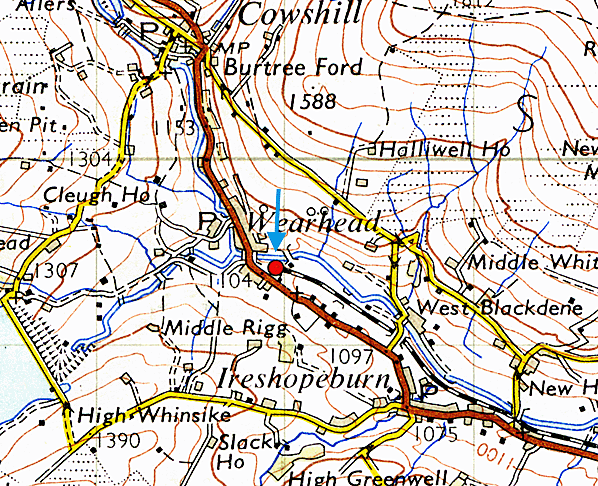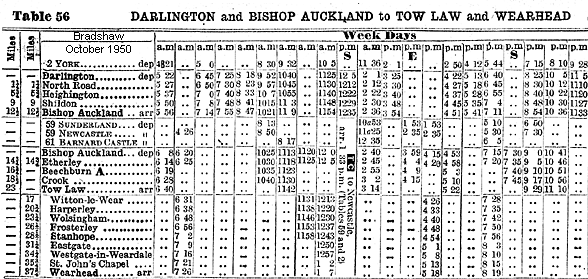|
Notes: Wearhead is about 1100 feet above sea level and was
the terminus of the Wear Valley Extension Railway. It was 22
miles from Wear Valley Junction.
The station layout was quite complex, containing a single road
engine shed, turntable, signal box, goods warehouse, water column
and a run round loop. The branch engine was stabled at Wearhead,
being a sub shed of West Auckland. The last engine to be stabled
there was class J21 0-6-0 no. 314 later 65064.
 |
Principle traffic dispatched in 1923 was roadstone 29000 tons,
clay and ganister 8,600 tons.After WW1 the Durham County Water Board proposed an enlarged
Burnhope Reservoir for which they obtained an Act of parliament
in 1922. The Act provided for a tramway from Wearhead to Burnhope
with a siding connection at Burnhope goods yard and a long holding |
siding was built in 1930 for water board traffic. Construction
of the resrvoir was completed in 1936 but the tramway was never
built and the siding at Wearhead was abandoned. The agreement
with the LNER was terminated on 2.9.1935..
Wearhead Station was closed to all traffic on 2nd January 1961,
when the line was cut back to St. Johns Chapel. For a time some
of the sidings were used to store redundant wagons and track
was still in place in August 1963.
After closure the station yard was occupied by A. Corbett &
Son as an office and base for lorries. The locomotive shed was
still standing but its single road had been lifted. By 1977
the station area was occupied by J. Hodson Ltd, a Landrover
agency, the brick goods shed had been restored as a store. A
bungalow has now been build behind the former station building
and the back wall of the station building has been retained.
The former station masters house has been converted into a private
residence and the locomotive shed has been demolished.
BRIEF HISTORY OF THE WEAR VALLEY
RAILWAY (this is a shortened version taken from the Weardale
Railway Project web site. Click here
for the full version)
It was in the early days of the Stockton & Darlington Railway
Company, that a railway to tap the mineral wealth of Weardale
was first considered. However, it wasn't until November 1843
when the Bishop Auckland & Weardale Railway was opened from
Shildon Junction to Crook that any real attempt was made to
penetrate the dale. The line was leased and worked by the Stockton
& Darlington Railway. An extension of this line in 1845
from Crook to Waskerley was opened to serve as another outlet
for the Derwent Iron Company at Consett. The section of line
was originally called the Weardale Extension Railway but later
under a merger with the line from Stanhope to Consett, was known
as the Wear & Derwent Junction Railway.
|
A plan to penetrate Weardale proper was covered by the
Wear Valley Act of July 1845, which was to provide a line
from Witton Junction (Wear Valley Junction) on the Bishop
Auckland & Weardale Railway to Frosterley, with a
connecting branch to Bishopley, this opened on 3rd August
1847. A plan to penetrate Weardale proper was covered
by the Wear Valley Act of July 1845, which was to provide
a line from Witton Junction (Wear Valley Junction) on
the Bishop Auckland & Weardale Railway to Frosterley,
with a connecting branch to Bishopley, this opened on
3rd August 1847.
In 1862 the Wear Valley line was extended to Stanhope
by the Frosterley & Stanhope Railway, mainly to reach
the Newlandside Estate on the south side of the town where
large quantities of limestone were known to exist. The
final extension of the Wear Valley line to Wearhead was
opened on 21st October 1895. It was impossible to extend
the line from the existing station at Stanhope and a new
one was built.
|
|
Between Eastgate and Westgate at Cambo
Keels, sidings were established to serve the Weardale Iron
Company's Heights limestone quarry. This quarry is still operational
today.
The passenger train service survived until 29th June 1953.
Up until closure, four trains per day had served the stations
of Witton-Le-Wear, Harperley, Wolsingham, Frosterley, Stanhope,
Eastgate, Westgate-in-Weardale, St. Johns Chapel and Wearhead.
The freight service to Wearhead survived until 1961 when the
line was cut back the St. John's Chapel. West of Eastgate followed
in 1968, which is the present terminus.
Eastgate cement works were established in 1964 and brought
new life to the Wear valley line. Utilising purpose built container
wagons, cement was transported mainly by rail from the plant
to Teesside, Tyneside and Scotland. This operation ceased on
17th March 1993.
The line which existed until 2004 was single throughout between
Eastgate and Shildon. There is a connecting spur into Bishop
Auckland station - the terminus of the 'Heritage Line' |
 |
passenger
service from Darlington. A summer only Sunday passenger train
service to Stanhope operated as an extension to the Darlington
service between 1988 & 1992. The success of this service
was instrumental in reopening the station at Etherley (renamed
Witton Park), in August 1991.
 |
A campaign to save the line west of Bishop Auckland, now known
as the Weardale Railway, began in 1993 with the threat of closure
and track uplift a real possibility after the last cement train
ran. Until 2004, the line was mothballed, but purchase by Weardale
Railways Limited has now been achieved and the first works trains
began running in 2004 in preparation for |
the reopening of the
first section between Stanhope and Wolsingham in July 2004.
In February 2005 Weardale Railways Ltd, the company operating
the line ran into financial difficulties and it was necessary
to call in an administrator. No service operated during 2005
but the Weardale Railway Project are hopeful of of a satisfactory
outcome in the near future with a resumption of services some
time in 2006.
See The
Weardale Railway Project web site. Tickets from Michael Stewart
Click here
for Roy Lambeth's memories of the Wear Valley line in the late
1950's & 1960's
To see the other
stations on the Wear Valley Railway click on the station name:
Bishop Auckland,
Etherley, Wear
Valley Junction, Witton-le-Wear,
Harperley, Wolsingham,
Frosterley, Stanhope
(1st), Stanhope (2nd),
Eastgate, Westgate-in-Weardale
& St. John's
Chapel
|




 Home
Page
Home
Page

















